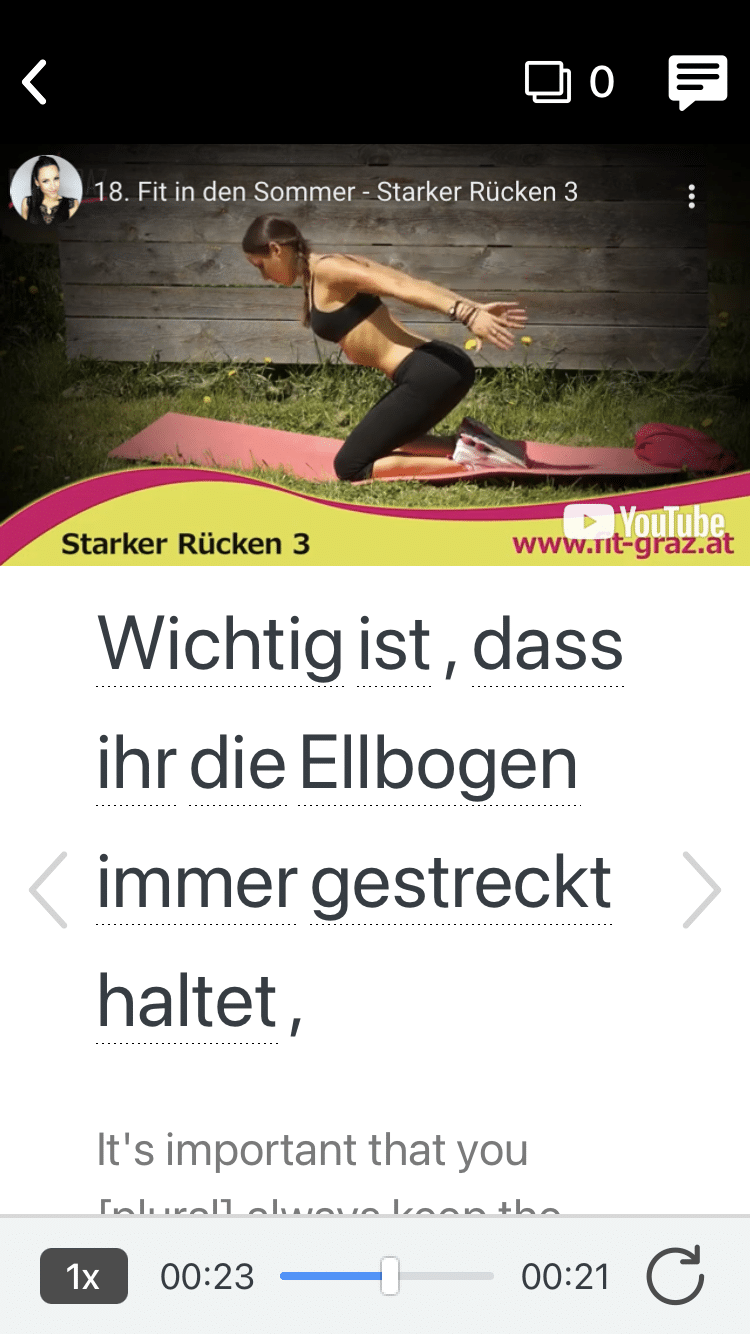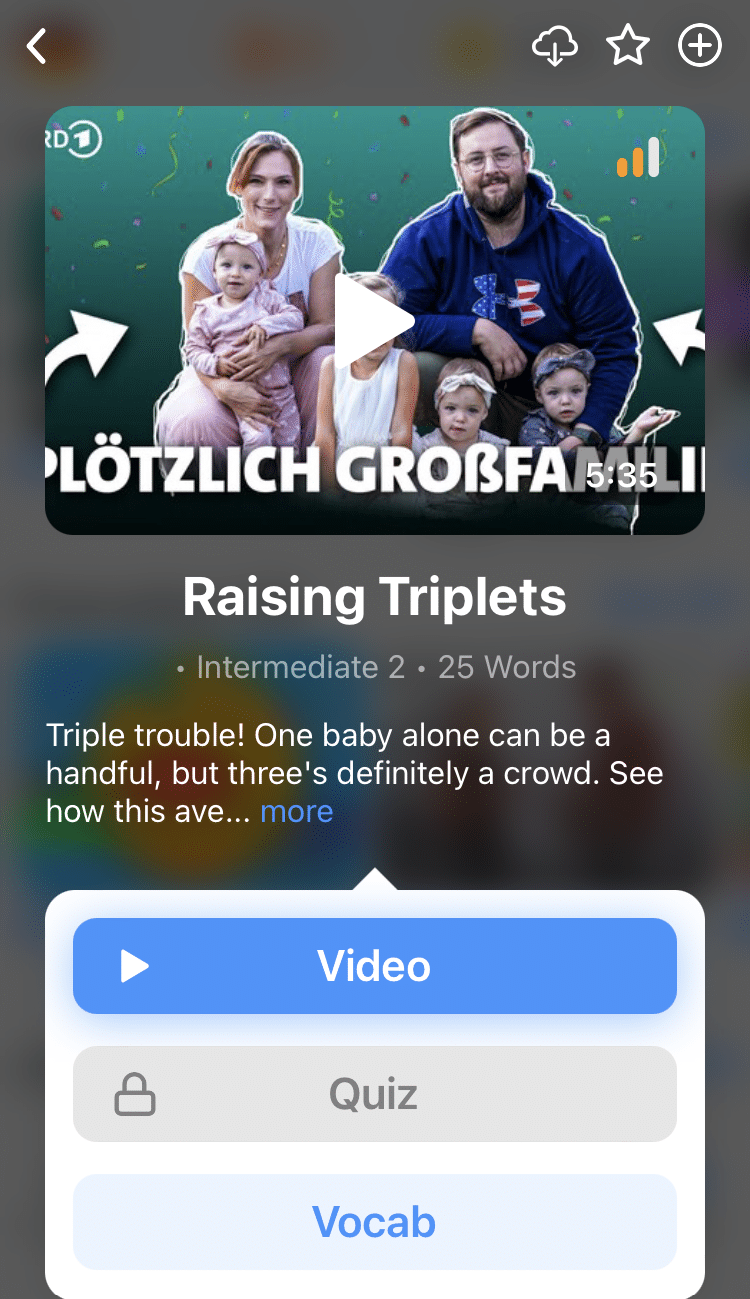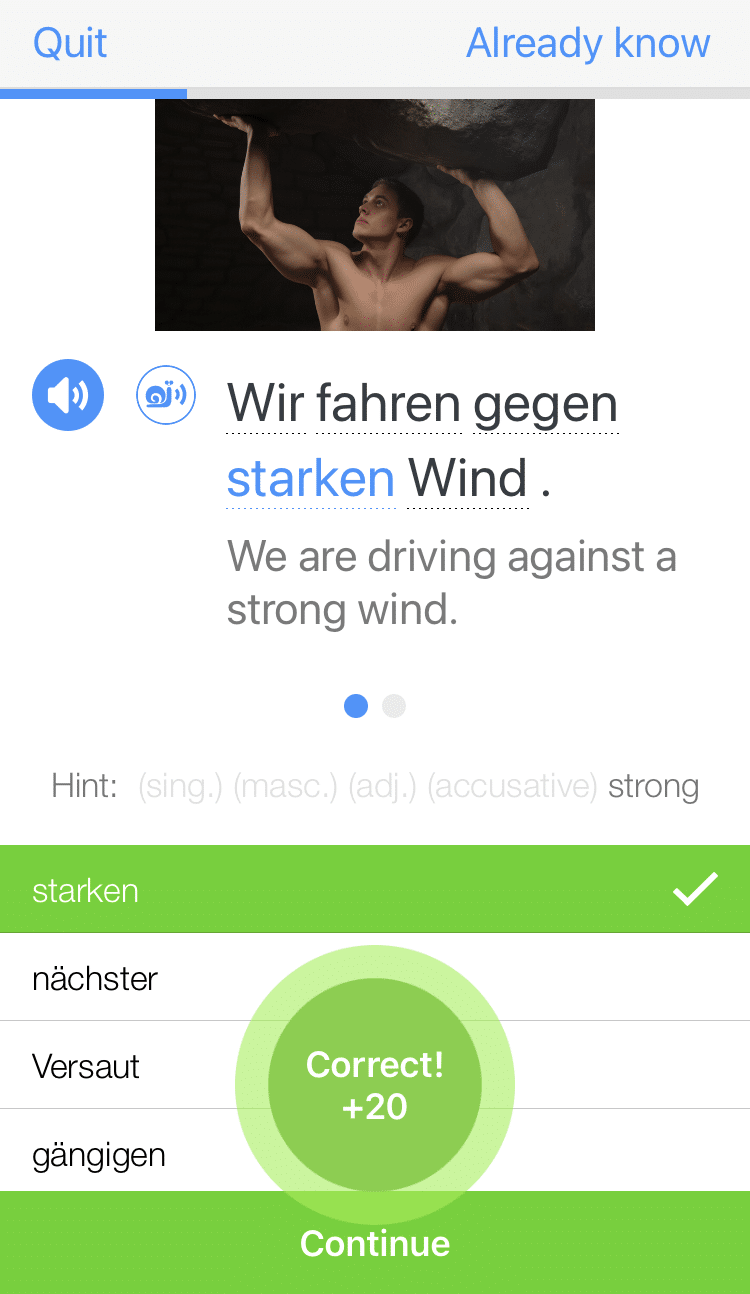
How to Learn the German Passive Voice
All your active German learning has created something beautiful, but now it is time to take another step back.
It is time to learn the German passive voice!
Like the English language, German has two “voices.” These voices are two different ways to arrange a sentence in order to establish a certain distance between the speaker and the content of the sentence.
But what do these sentences really look like? How are they formed in German? Let’s dive in!
Contents
- Das Activ vs. Das Passiv (the Active vs. the Passive)
- Creating the Passive Voice in German
- Passive Sentences in All Tenses
- The Passive with Modals
- Statal Passive
- Practice the Passive Voice
- And One More Thing...
Download: This blog post is available as a convenient and portable PDF that you can take anywhere. Click here to get a copy. (Download)
Das Activ vs. Das Passiv (the Active vs. the Passive)
In its simplest form, an active sentence is one where the subject of the sentence is the noun doing or performing the verb. For example, in the sentence Der Mann hat den Kaffee getrunken (the man drank the coffee), der Mann is both the subject of the sentence and it is performing the action of drinking (trinken). Further, because it is the subject, it is in the nominative case.
If we look at the other noun in the sentence, den Kaffee, we can see that it is in the accusative case because it is being acted upon by the subject: it is being drunk by the subject, der Mann. In other words, it is the direct object.
Now let’s make this into a passive sentence:
Der Kaffee ist von dem Mann getrunken worden. (The coffee has been drunk by the man.)
From a stylistic standpoint, the passive sentence feels less direct and even more objective because the emphasis is no longer on the noun performing the action of drinking, der Mann.
In fact, we could also omit the noun Mann from the sentence altogether. This would render the sentence without an agent (a doer of the verb):
Der Kaffee ist getrunken worden. (The coffee has been drunk.)
This would create a more objective sentence, one that may even be viewed as uncertain since it does not denote who has actually consumed the beverage.
Creating the Passive Voice in German
The first thing to ensure when creating a passive sentence in German is that you have the required element: a direct object (or the noun being acted upon by the verb). We have already mentioned above that an agent (a doer) is not needed.
It is especially important to note that only verbs that take a direct object can be put in the passive voice. That means that verbs that take an indirect object cannot be put into the passive voice.
For example, in English we can change the active sentence “My mom gave me a gift” into the passive “I was given a gift by my mom.” This is impossible in German because the element that moved (the “me” in the active sentence) is actually an indirect object: it is not the noun being acted on by the verb but rather the receiver of the verb.
That said, to create the passive voice in German, you must move the direct object noun into the subject position at the beginning of the sentence.
Further, this means that the direct object now must be in the nominative case. Revisiting the previous passive German sentence, the noun Kaffee went from being den Kaffee (in the accusative case) in the active sentence to der Kaffee (in the nominative case) in the passive sentence.
Consequently, der Mann (in the nominative case in the active sentence) also changed its case: it is in the dative case in the passive sentence triggered by the preposition von (by).
In addition to these case changes, the passive sentence also requires a conjugation of the verb werden (to become). This takes the place of the verb “to be” that English speakers use for the passive voice:
Der Kaffee ist getrunken worden. (The coffee has been drunk.)
In conjunction with the past participle of the main verb (getrunken in our example sentence), we can form the passive voice in multiple tenses.
Conjugating Werden for the Passive Voice
Aside from ensuring that the nouns get the correct cases in the passive sentence, we also need to make sure that werden is conjugated and placed correctly in the passive sentence.
In fact, to use the passive voice, you will need to know the conjugation of werden in the present, the present perfect, the simple past, the past perfect, the future and the future perfect tenses. Let’s review them now before moving any further!
The present tense of werden is as follows:
Ich werde (I become)
Du wirst (you [singular] become)
Er/sie/es wird (he/she/it becomes)
Wir werden (we become)
Ihr werdet (you [plural] become)
Sie werden (they become)
In the present perfect tense of werden, the past participle is normally geworden, but this is shortened to simply worden in the passive voice:
Ich bin (ge)worden (I have become)
Du bist (ge)worden (you [singular] have become)
Er/sie/es ist (ge)worden (he/she/it has become)
Wir sind (ge)worden (we have become)
Ihr seid (ge)worden (you [plural] have become)
Sie sind (ge)worden (they have become)
The simple past tense of werden is as follows:
Ich wurde (I became)
Du wurdest (you [singular] became)
Er/sie/es wurde (he/she/it became)
Wir wurden (we became)
Ihr wurdet (you [plural] became)
Sie wurden (they became)
In the past perfect tense of werden, the past participle is normally geworden, but this is shortened to simply worden in the passive voice:
Ich war (ge)worden (I had become)
Du warst (ge)worden (you [singular] had become)
Er/sie/es war (ge)worden (he/she/it had become)
Wir waren (ge)worden (we had become)
Ihr wart (ge)worden (you [plural] had become)
Sie waren (ge)worden (they had become)
The future tense of werden is as follows:
Ich werde werden (I will become)
Du wirst werden (you [singular] will become)
Er/sie/es wird werden (he/she/it will becomes)
Wir werden werden (we will become)
Ihr werdet werden (you [plural] will become)
Sie werden werden (they will become)
In the future perfect tense of werden, the past participle is normally geworden, but this is shortened to simply worden in the passive voice:
Ich werde (ge)worden sein (I will have become)
Du wirst (ge)worden sein (you [singular] will have become)
Er/sie/es wird (ge)worden sein (he/she/it will have become)
Wir werden (ge)worden sein (we will have become)
Ihr werdet (ge)worden sein (you [plural] will have become)
Sie werden (ge)worden sein (they will have become)
Von vs. Durch (By vs. Through)
When the direct object of the active sentence moves to the subject position in the passive sentence, the old subject can remain connected to the sentence through the preposition von. This old subject is then in the dative case triggered by that preposition.
As such, masculine and neuter nouns in the dative take dem (the), and this can combine with von to become vom. Feminine and plural nouns do not combine with the preposition von but remain with the dative articles der and den respectively. Let’s check out some example sentences:
Der Kaffee ist von dem Mann getrunken worden (the coffee has been drunk by the man) shows von and the masculine article dem.
Der Kaffee ist von dem Mädchen getrunken worden (the coffee has been drunk by the girl) shows von and the neuter article dem. Note that Mädchen is a neuter noun despite meaning “girl.”
Der Kaffee ist von der Frau getrunken worden (the coffee has been drunk by the woman) shows von unchanged while preceding the dative, feminine article der.
Der Kaffee ist von den Leuten getrunken worden (the coffee has been drunk by the people) shows von unchanged while preceding the dative, plural article den.
As you can see in our example sentences above, von is used to connect old subjects that are people in passive sentences.
For nouns that are not people, we use the preposition durch (through). For example, we would say das Boot ist durch das Meer zerstört worden (the boat has been destroyed by the ocean) because das Meer is not a noun that denotes a person and therefore we must use the preposition durch.
Further, the preposition durch triggers the accusative case, so all following nouns must be in the accusative.
Let’s check out some example sentences:
Das Boot ist durch den See zerstört worden (the boat has been destroyed by the sea) shows the accusative den in front of the noun See because it is a masculine noun.
Das Boot ist durch das Meer zerstört worden (the boat has been destroyed by the ocean) shows the accusative das in front of the noun Meer because it is a neuter noun.
Die Blumen sind durch die Hitze zerstört worden (the flowers have been destroyed by the heat) shows the accusative die in front of the noun Hitze because it is a feminine noun.
Die Blumen sind durch die Graupeln zerstört worden (the flowers have been destroyed by the ice pellets) shows the accusative die in front of the noun Graupeln because it is a plural noun.
These same rules also apply when using indefinite articles such as ein and eine (a/an) in passive sentences. If you are using the preposition von, these indefinite articles must be in the dative case. However, if you are using the preposition durch, these indefinite articles must be in the accusative case.
One last note: Keep in mind that while it is the academic rule that von must be used for nouns that are people and durch must be used for all other nouns, this is not always the case in practice. Mistakes are made all the time, even by native speakers, and these mistakes do not really hinder the conversation or change the meaning of what is being conveyed in the passive voice.
You can get a closer look at how native speakers use the passive voice conversationally on FluentU.
FluentU takes authentic videos—like music videos, movie trailers, news and inspiring talks—and turns them into personalized language learning lessons.
You can try FluentU for free for 2 weeks. Check out the website or download the iOS app or Android app.
P.S. Click here to take advantage of our current sale! (Expires at the end of this month.)
Passive Sentences in All Tenses
By using our example sentence from the beginning of this post, we can see how the the passive voice is formed and what it means in all six tenses:
Present tense: Der Kaffee wird von dem Mann getrunken worden. (The coffee is being drunk by the man.)
Present perfect tense: Der Kaffee ist von dem Mann getrunken worden. (The coffee has been drunk by the man.)
Simple past tense: Der Kaffee wurde von dem Mann getrunken. (The coffee was drunk by the man.)
Future tense: Der Kaffee wird von dem Mann getrunken werden. (The coffee will be drunk by the man.)
Future perfect tense: Der Kaffee wird von dem Mann getrunken worden sein. (The coffee will have been drunk by the man.)
Keep in mind that all tenses must follow the rules of word order and verb placement in German. That means that the conjugation of werden takes the second position in the sentence—the position that is generally occupied by the first verb in a declarative sentence.
Next, the past participle (getrunken in our example sentence) comes after the noun connected with von or durch.
After that comes the past participle of werden, if applicable. This is in the form of the shortened worden or the infinitive werden itself (as seen and as required in the future tense). Do not forget that the future perfect tense takes an extra infinitive sein at the very end of the passive sentence.
The Passive with Modals
The passive voice can also be created with modal verbs. In both German and English, modal verbs allow speakers to relate themselves or other nouns with another verb. For example, in the sentence ich kann Spanisch nicht sprechen (I cannot speak Spanish), we learn about the speaker’s connection with the main verb, sprechen (to speak).
Common modal verbs include können (to be able to), müssen (to have to) and sollen (to “should”).
For all tenses except the future and the future perfect, the modal gets conjugated but werden is not conjugated. Instead, the werden becomes an infinitive that comes at the end of the sentence since the modal verb is taking the second position in the sentence—the “first verb” position that gets conjugated.
For the future and future perfect tenses, however, the modal also becomes an infinitive (as is standard for main verbs in future tenses), and it, too, goes to the end of the sentence.
Additionally, the past participle is still used, and the modal verb is able to conjugate in any of the six tenses allowed by the passive voice.
Here are some examples of the passive voice with modal verbs:
Der Kaffee kann von em Mann getrunken werden. (The coffee can be drunk by the man.)
Der Kaffee musste von dem Mann getrunken werden. (The coffee had to be drunk by the man.)
Der Kaffee wird von dem Mann getrunken werden müssen. (The coffee will have to be drunk by the man.)
Statal Passive
Up until now, we have seen examples of the passive voice where an action is occurring within the context of the sentence. Otherwise said, in these uses of the passive voice, the verb is being performed. There is, however, a second form of the passive voice called the “statal passive.”
The statal passive is a form of the passive that describes the condition or state of something. An example of this would be das Boot ist zerstört (the boat is destroyed). In this sentence, there is no actor: we do not know who or what has destroyed the boat, we just know that the boat is in a state of destruction.
In the statal passive, the verb sein (to be) is used in place of werden, followed by the past participle. Unlike the other passive voice, an object is never joined to the sentence with the prepositions von or durch. Further, the previously mentioned six verb tenses can be used with the statal passive.
Practice the Passive Voice
Pulse check: How are you feeling about the passive voice? Confident? Kind of insecure? Overwhelmed?
Regardless, the best way to get the hang of the passive voice is to practice. Practice makes perfect, and in the case of German grammar, practice leads to fluidity and comfort.
For starters, Lingolia Deutsch allows you to practice both forms of the passive (the normal passive and the statal passive). Or, you can listen to native speakers using the passive voice in action with the FluentU program. You can watch authentic German videos with interactive captions here, and also create flashcards decks for further practice.
Next, try your hand at some complex verb conjugation patterns with the passive voice: German.net has passive practice in all six tenses. Once you’ve gotten the hang of that, ToLearnFree has one quiz with a mix of tenses in the passive voice.
For more mixed practice, Study.com has a short quiz that is multiple choice and the University of Michigan has multiple exercises to practice the passive voice.
Nothing like an active German workout to get your juices flowing and your language skills increasing! In fact, I would say you are well on your way to mastering the passive, German onlooker!
Download: This blog post is available as a convenient and portable PDF that you can take anywhere. Click here to get a copy. (Download)
And One More Thing...
Want to know the key to learning German effectively?
It's using the right content and tools, like FluentU has to offer! Browse hundreds of videos, take endless quizzes and master the German language faster than you've ever imagine!
Watching a fun video, but having trouble understanding it? FluentU brings native videos within reach with interactive subtitles.
You can tap on any word to look it up instantly. Every definition has examples that have been written to help you understand how the word is used. If you see an interesting word you don't know, you can add it to a vocabulary list.
And FluentU isn't just for watching videos. It's a complete platform for learning. It's designed to effectively teach you all the vocabulary from any video. Swipe left or right to see more examples of the word you're on.
The best part is that FluentU keeps track of the vocabulary that you're learning, and gives you extra practice with difficult words. It'll even remind you when it’s time to review what you’ve learned.
Start using the FluentU website on your computer or tablet or, better yet, download the FluentU app from the iTunes or Google Play store. Click here to take advantage of our current sale! (Expires at the end of this month.)







